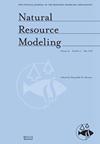离散种群模型中收获时机的最优控制
IF 2.1
4区 环境科学与生态学
Q3 ENVIRONMENTAL SCIENCES
引用次数: 4
摘要
收获在从渔业到虫害防治的管理决策中起着重要作用。离散时间模型使我们能够探索管理决策时机的重要性,包括特定行动的事件顺序。我们推导出具有明确的季节内收获时间和水平的新型机制模型。我们通过对这些种群模型的最优控制来探索季内收获水平和时间的优化。在固定的收获水平下,以收获时间为控制。然后,收割时间和关卡都被用作控制。我们最大化一个目标函数,其中包括最大化产量,最大化库存和最小化与收获强度和收获时间相关的成本的管理目标。虽然具有补偿种群动态的标准模型预测在季节中尽可能早地收获是最好的,但我们发现在季节后期收获是最佳的实例。此外,我们发现了种群大小的有趣振荡,这在没有时变控制的模型中是意想不到的。本文章由计算机程序翻译,如有差异,请以英文原文为准。
Optimal control of harvest timing in discrete population models
Harvest plays an important role in management decisions, from fisheries to pest control. Discrete‐time models enable us to explore the importance of timing of management decisions, including the order of events of particular actions. We derive novel mechanistic models featuring explicit within‐season harvest timing and level. We explore optimization of within‐season harvest level and timing through optimal control of these population models. With a fixed harvest level, harvest timing is taken as the control. Then both harvest timing and level are used as controls. We maximize an objective functional which includes management goals of maximizing yield, maximizing stock, and minimizing costs associated with both harvest intensity and harvest timing. While standard models with compensatory population dynamics predict it is best to harvest as early as possible in the season, we find instances where harvesting later in the season is optimal. Furthermore, we discover interesting oscillations in the population size, which would be unexpected in the model without time‐varying controls.
求助全文
通过发布文献求助,成功后即可免费获取论文全文。
去求助
来源期刊

Natural Resource Modeling
环境科学-环境科学
CiteScore
3.50
自引率
6.20%
发文量
28
审稿时长
>36 weeks
期刊介绍:
Natural Resource Modeling is an international journal devoted to mathematical modeling of natural resource systems. It reflects the conceptual and methodological core that is common to model building throughout disciplines including such fields as forestry, fisheries, economics and ecology. This core draws upon the analytical and methodological apparatus of mathematics, statistics, and scientific computing.
 求助内容:
求助内容: 应助结果提醒方式:
应助结果提醒方式:


